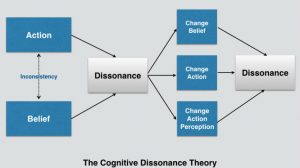This weeks assignment it to choose a complex term in our field of study, or work, and define it in three different ways (parenthetical, sentence, and expanded) for our writing teams. As people may come from different fields/backgrounds it is imperative that, as a writer, one can communicate the context needed for an in-depth understanding. These definitions can come in different forms depending on the audiences’ expertise in the subject and the writer’s purpose. For this assignment, I chose the word cognitive dissonance, a term commonly used in psychology, which I will define in each of the three forms.
Parenthetical
Jamie, who is an avid animal activist may experience cognitive dissonance (psychological stress) when eating burgers on a night out with friends.
Sentence
Cognitive dissonance is a state that is caused by an inconsistency between a persons beliefs, attitudes, and actions. This state is characterized by a state of psychological stress that lasts until beliefs, attitudes and actions align.
Expanded
Cognitive dissonance
What is Cognitive Dissonance?
Cognitive dissonance is a state that is caused by an inconsistency between a persons beliefs, attitudes, and actions. This means that a person may hold two or more contradictory beliefs or may do an action that goes against a belief. When this occurs a state of psychological stress ensues and persists until either one belief is chosen or the persons actions and beliefs start to meet.
History
The state of cognitive dissonance was put forward in theory of cognitive dissonance proposed by Leon Festinger in 1957 (Metin, 131). Festinger’s theory had a substantial impact in the field and replaced the theory of reinforcement as the main focus of social psychology (Metin, 131). The reinforcement theory focused the social and behavioural aspect anxiety and how it can be resolved by conforming to the group (Metin, 131). The cognitive dissonance theory instead put the focus on the cognition (thinking) of a person and how anxiety may arise within oneself and can help explain behavior (Metin, 131).
Required conditions and Reduction Strategies
Cognitive dissonance theory relies on the notion that humans want to be consistent in their beliefs, attitudes, and actions. Any inconsistencies, or dissonance, that occurs between any of these elements results in a state of psychological distress. Therefore to experience any distress there must exist an inconsistency. There are two main forms of cognitive dissonance. The first, is when there are two or more opposing beliefs that one person holds, and the greater the disparity between the beliefs the greater the distress. The second, is when ones beliefs doesn’t align with their actions, which leads to a similar distress as the first form. The differences between actions and beliefs and between a belief and another opposite belief is called the “magnitude of dissonance,” which has an impact on the level of psychological stress (Boring, 683). Experiencing distress people try and seek ways to alleviate themselves by implementing one of four strategies. A person can either (1) alter their behavior, (2) explain the behavior or thought by changing the conflicting thought, (3) explain the behavior or cognition by creating additional actions or beliefs, (4) or deny that any actions that may have conflicted with the beliefs (Festinger). After implementing any of the four coping strategies, a person will then reassess their state of cognitive dissonance until there is little to no anxiety or stress left.
Example
A common example of this occurs when someone considers themselves a ex smoker but they end up smoking a cigaret. The person finding a inconsistency between their belief, of being an ex smoker, and their actions, smoking, would begin to experience psychological distress. They would then: 1) decide to never smoke again again 2) they think “nobody perfect. I can get away with it this one time because I rarely mess up” 3) they decide to make up for the mistake by eating healthy foods for the rest of the week 4) they deny that one cigaret will have any lasting impact on them as an ex smoker and they will be just fine. Taking any one of these four steps will help reduce their cognitive dissonance.
Visual

Figure 1. Shows a two step process in (step 1) how cognitive dissonance originally occurs and (step 2) three ways in which a person can try and reduce/eliminate any dissonance. This shows the second main form of cognitive dissonance where ones actions and beliefs do not align. (Pappas).
Citation
Boring, Edwin G. “Cognitive Dissonance: Its Use in Science.” Science, vol. 145, no. 3633, 1964, pp. 680–685. JSTOR, www.jstor.org/stable/1713761. Accessed 4 June 2020.
Metin, Irem, and Selin Camgoz. “The Advances in the History of Cognitive Dissonance .” International Journal of Humanities and Social Science , vol. 1, no. 6, 2011, pp. 131–36. Google Scholar.
Pappas, Christopher. “3 Tips To Apply The Cognitive Dissonance Theory In ELearning.” ELearning Industry, 23 Sept. 2019, elearningindustry.com/apply-cognitive-dissonance-theory-elearning.